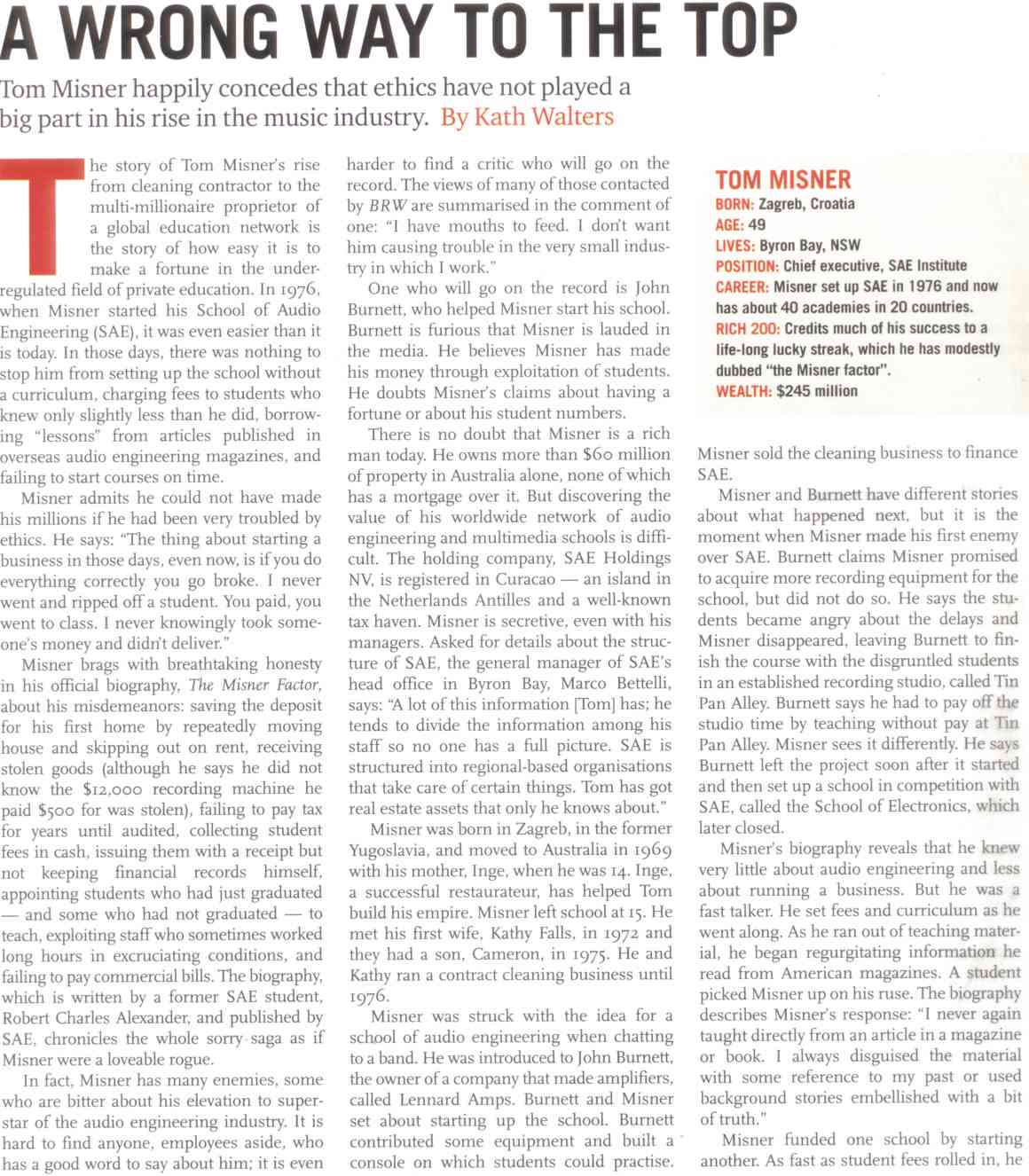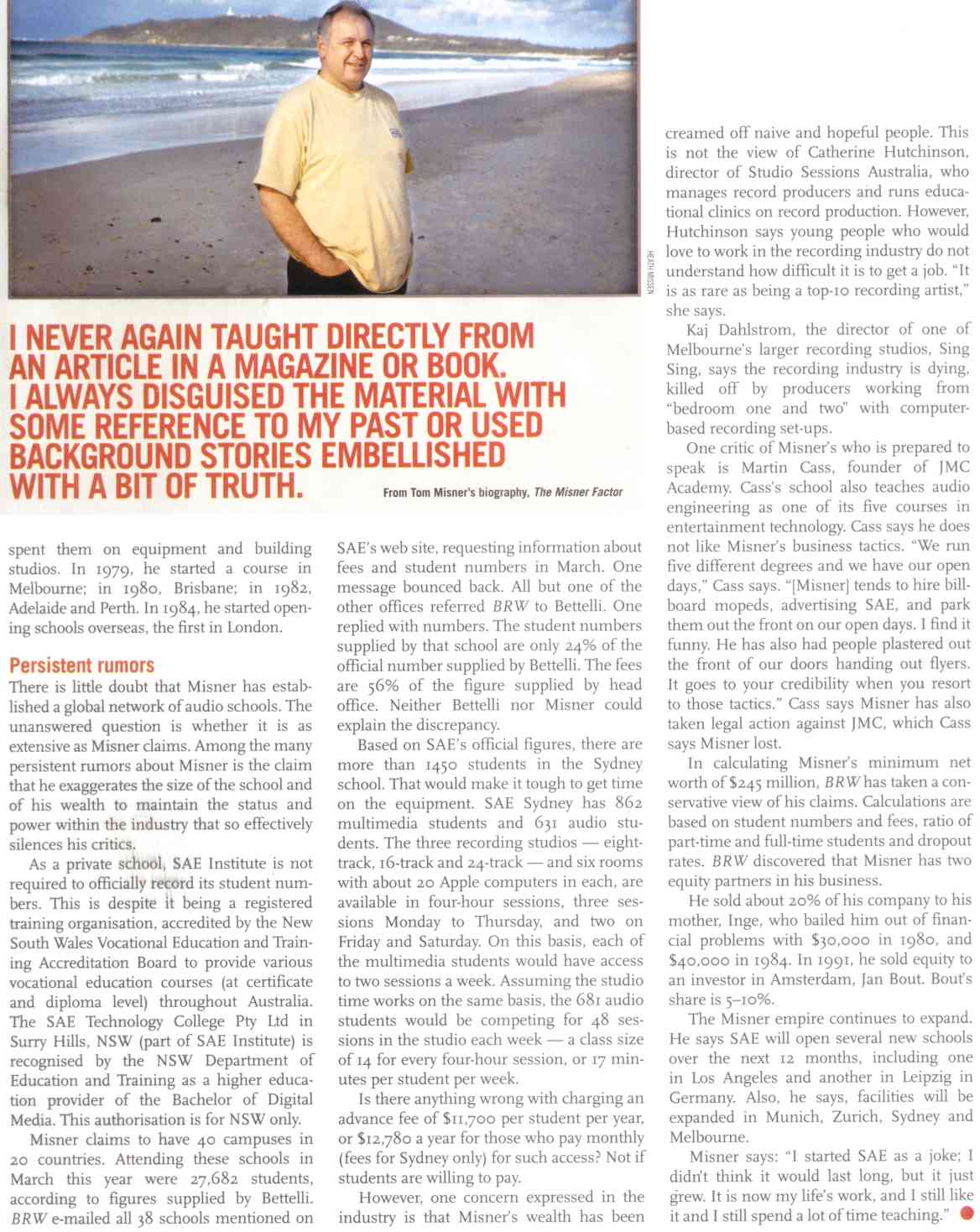Business Review Weekly
Business Review Weekly (Fairfax press)
BRW Rich 200 (May 20 - July 14, 2004)
ISSN 0727-7458
Scanned 2 Page feature editorial Pages 64(167K) and 65(170K)


Text File for printing.
Business Review Weekly (Fairfax press)
BRW Rich 200 (May 20 - July 14, 2004)
ISSN 0727-7458
2 Page feature editorial Pages 64 and 65
A WRONG WAY TO THE TOP
Tom Misner happily concedes that ethics have not played a big part in his rise in the music industry. By Kath Walters
The story of Tom Misner's rise from cleaning contractor to the multi-millionaire proprietor of a global education network is the story of how easy it is to make a fortune in the under-regulated field of private education. In 1976, when Misner started his School of Audio Engineering (SAE), it was even easier than it is today. In those days, there was nothing to stop him from setting up the school without a curriculum, charging fees to students who knew only slightly less than he did, borrowing "lessons" from articles published in overseas audio engineering magazines, and failing to start courses on time.
Misner admits he could not have made his millions if he had been very troubled by ethics. He says: "The thing about starting a business in those days, even now, is if you do everything correctly you go broke. I never went and ripped off a student. You paid, you went to class. I never knowingly took someone's money and didn't deliver."
Misner brags with breathtaking honesty in his official biography, The Misner Factor, about his misdemeanors: saving the deposit for his first home by repeatedly moving house and skipping out on rent, receiving stolen goods (although he says he did not know the $12,000 recording machine he paid $500 for was stolen), failing to pay tax for years until audited, collecting student fees in cash, issuing them with a receipt but not keeping financial records himself, appointing students who had just graduated - and some who had not graduated - to teach, exploiting staff who sometimes worked long hours in excruciating conditions, and failing to pay commercial bills. The biography, which is written by a former SAE student, Robert Charles Alexander, and published by SAE, chronicles the whole sorry saga as if Misner were a loveable rogue.
In fact, Misner has many enemies, some who are bitter about his elevation to superstar of the audio engineering industry. It is hard to find anyone, employees aside, who has a good word to say about him; it is even harder to find a critic who will go on the record. The views of many of those contacted by BRW are summarised in the comment of one: "I have mouths to feed. I don't want him causing trouble in the very small industry in which I work."
One who will go on the record is John Burnett, who helped Misner start his school. Burnett is furious that Misner is lauded in the media. He believes Misner has made his money through exploitation of students. He doubts Misner's claims about having a fortune or about his student numbers.
There is no doubt that Misner is a rich man today. He owns more than $60 million of property in Australia alone, none of which has a mortgage over it. But discovering the value of his worldwide network of audio engineering and multimedia schools is difficult. The holding company, SAE Holdings NV, is registered in Curacao - an island in the Netherlands Antilles and a well-known tax haven. Misner is secretive, even with his managers. Asked for details about the structure of SAE, the general manager of SAE's head office in Byron Bay, Marco Bettelli, says: "A lot of this information [Tom] has; he tends to divide the information among his staff so no one has a full picture. SAE is structured into regional-based organisations that take care of certain things. Tom has got real estate assets that only he knows about."
Misner was born in Zagreb, in the former Yugoslavia, and moved to Australia in 1969 with his mother, Inge, when he was 14. Inge, a successful restaurateur, has helped Tom build his empire. Misner left school at 15. He met his first wife, Kathy Falls, in 1972 and they had a son, Cameron, in 1975. He and Kathy ran a contract cleaning business until 1976.
Misner was struck with the idea for a school of audio engineering when chatting to a band. He was introduced to John Burnett, the owner of a company that made amplifiers, called Lennard Amps. Burnett and Misner set about starting up the school. Burnett contributed some equipment and built a console on which students could practise. Misner sold the cleaning business to finance SAE.
Misner and Burnett have different stories about what happened next, but it is the moment when Misner made his first enemy over SAE. Burnett claims Misner promised to acquire more recording equipment for the school, but did not do so. He says the students became angry about the delays and Misner disappeared, leaving Burnett to finish the course with the disgruntled students in an established recording studio, called Tin Pan Alley. Burnett says he had to pay off the studio time by teaching without pay at Tin Pan Alley. Misner sees it differently. He says Burnett left the project soon after it started and then set up a school in competition with SAE, called the School of Electronics, which later closed.
Misner's biography reveals that he knew very little about audio engineering and less about running a business. But he was a fast talker. He set fees and curriculum as he went along. As he ran out of teaching material, he began regurgitating information he read from American magazines. A student picked Misner up on his ruse. The biography describes Misner's response: "I never again taught directly from an article in a magazine or book. I always disguised the material with some reference to my past or used background stories embellished with a bit of truth."
Misner funded one school by starting another. As fast as student fees rolled in, he spent them on equipment and building studios. In 1979, he started a course in Melbourne; in 1980, Brisbane; in 1982, Adelaide and Perth. In 1984, he started opening schools overseas, the first in London.
Persistent rumors
There is little doubt that Misner has established a global network of audio schools. The unanswered question is whether it is as extensive as Misner claims. Among the many persistent rumors about Misner is the claim that he exaggerates the size of the school and of his wealth to maintain the status and power within the industry that so effectively silences his critics.
As a private school, SAE Institute is not required to officially record its student numbers. This is despite it being a registered training organisation, accredited by the New South Wales Vocational Education and Train-ing Accreditation Board to provide various vocational education courses (at certificate and diploma level) throughout Australia. The SAE Technology College Pty Ltd in Surry Hills, NSW (part of SAE Institute) is recognised by the NSW Department of Education and Training as a higher education provider of the Bachelor of Digital Media. This authorisation is for NSW only.
Misner claims to have 40 campuses in 20 countries. Attending these schools in March this year were 27,682 students, according to figures supplied by Bettelli. BRW e-mailed all 38 schools mentioned on SAE's web site, requesting information about fees and student numbers in March. One message bounced back. All but one of the other offices referred BRW to Bettelli. One replied with numbers. The student numbers supplied by that school are only 24% of the official number supplied by Bettelli. The fees are 56% of the figure supplied by head office. Neither Bettelli nor Misner could explain the discrepancy.
Based on SAE's official figures, there are more than 1450 students in the Sydney school. That would make it tough to get time on the equipment. SAE Sydney has 862 multimedia students and 631 audio students. The three recording studios - eight-track, 16-track and 24-track - and six rooms with about 20 Apple computers in each, are available in four-hour sessions, three sessions Monday to Thursday, and two on Friday and Saturday. On this basis, each of the multimedia students would have access to two sessions a week. Assuming the studio time works on the same basis, the 681 audio students would be competing for 48 sessions in the studio each week - a class size of 14 for every four-hour session, or 17 minutes per student per week.
Is there anything wrong with charging an advance fee of $11,700 per student per year, or $12,780 a year for those who pay monthly (fees for Sydney only) for such access? Not if students are willing to pay.
However, one concern expressed in the industry is that Misner's wealth has been creamed off naive and hopeful people. This is not the view of Catherine Hutchinson, director of Studio Sessions Australia, who manages record producers and runs educational clinics on record production. However, Hutchinson says young people who would love to work in the recording industry do not understand how difficult it is to get a job. "It is as rare as being a top-10 recording artist," she says.
Kaj Dahlstrom, the director of one of Melbourne's larger recording studios, Sing Sing, says the recording industry is dying, killed off by producers working from "bedroom one and two" with computer-based recording set-ups.
One critic of Misner's who is prepared to speak is Martin Cass, founder of JMC Academy. Cass's school also teaches audio engineering as one of its five courses in entertainment technology. Cass says he does not like Misner's business tactics. "We run five different degrees and we have our open days," Cass says. "[Misner] tends to hire billboard mopeds, advertising SAE, and park them out the front on our open days. I find it funny. He has also had people plastered out the front of our doors handing out flyers.
It goes to your credibility when you resort to those tactics." Cass says Misner has also taken legal action against JMC, which Cass says Misner lost.
In calculating Misner's minimum net worth of $245 million, BRW has taken a conservative view of his claims. Calculations are based on student numbers and fees, ratio of part-time and full-time students and dropout rates. BRW discovered that Misner has two equity partners in his business.
He sold about 20% of his company to his mother, Inge, who bailed him out of financial problems with $30,000 in 1980, and $40,000 in 1984. In 1991, he sold equity to an investor in Amsterdam, Jan Bout. Bout's share is 5-10%.
The Misner empire continues to expand. He says SAE will open several new schools over the next 12 months, including one in Los Angeles and another in Leipzig in Germany. Also, he says, facilities will be expanded in Munich, Zurich, Sydney and Melbourne.
Misner says: "I started SAE as a joke; I didn't think it would last long, but it just grew. It is now my life's work, and I still like it and I still spend a lot of time teaching."


